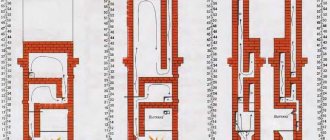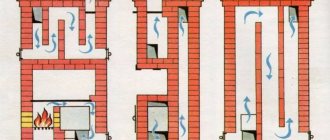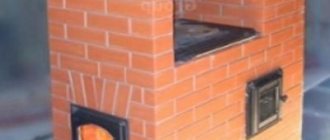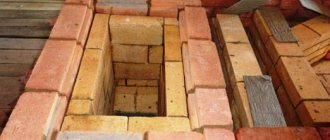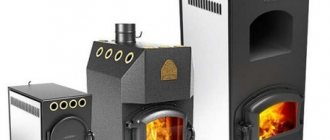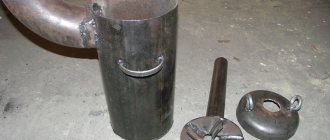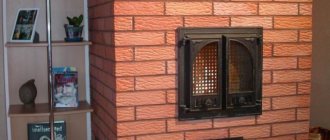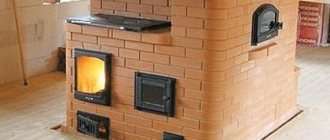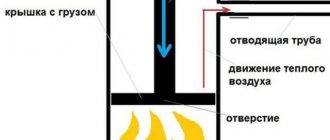Today, many are wondering how and what is the best way to heat their home if there is no gas. Firewood and coal are among the most affordable types of fuel. Therefore, the right solution here would be to build a heating stove, or even better, add a cooking stove function to it. There are a lot of design options both in form and in operating principles.
In this article I will introduce you to the features of the Kuznetsov furnace, its advantages and a step-by-step scheme for constructing such a unit yourself.
Features of the Kuznetsov furnace
Since the main goal of Kuznetsov’s developments was efficiency and productivity (he worked to increase the efficiency value), this required a fundamentally new and improved approach.
If you look at the drawings of Kuznetsov’s furnaces, every professional sees that he has thought out the system of internal gas movement most competently. As a result, thanks to the design solution, hot air lingers in the unit for a longer time and retains heat, and cooled air masses quickly fly away into the chimney through a special recess.
Such furnaces are called “bell-shaped” furnaces. Inside, they combine the hearth and the lower part, creating a kind of cap. Its functional purpose is to separate gases into cold and hot. The last of them rise into the bell and, lingering in it, concentrate the heat. The combustion temperature in such units is higher, and their efficiency is 95%. How much more efficient the functioning of the structures developed by Kuznetsov is is evidenced by the fact that for a traditional Russian stove this figure is 25-40%.
Advantages and disadvantages
The draft in the stove is carried out due to the voids inside.
The efficiency coefficient exceeds that of traditional stoves, for which it is in the range of 70 - 85%. In Kuznetsov’s designs, the soot burns out completely, so the period between two adjacent cleanings is calculated at 3–4 years.
Advantages of the inventor's models:
- traction is carried out due to the voids inside (caps), and not channels, so less brick is used;
- stoves operate on any fuel, not just wood;
- the use of a short smoke channel also saves money on arrangement;
- uniform heat transfer occurs throughout the day;
- it is possible to heat several levels of the house from one device;
- DHW and steam-water heating circuits are inserted into the design, and it is combined with a hob, a stove bench, an oven, and a fireplace.
Complex masonry is being carried out, which must be fully mastered before construction begins. Furnaces of this category have significant weight and are massive, so a solid foundation is needed.
Basic rules for creating a heating stove
- To make Kuznetsov stoves, the ordering (masonry diagrams) should be printed in advance.
- The refractory shell located inside the furnace must be free on all sides, since the brick expands during the heating process.
- Internal refractory masonry when using fireclay bricks is always done on edge. If the bricks are made of clay, on the inner walls and on the posts, they are laid at the discretion of the stove-maker.
- To strengthen the bond, a wire is laid every two brick rows.
- When a Kuznetsov stove is created, the ordering of brick stoves for a home provides that various elements (for example, doors) are installed in such a way that there is room for expansion. A special gasket is placed between the brick and the metal element.
- After completing the construction of a brick structure, it should be treated with a fire-resistant compound.
- The first kindling begins at a minimum temperature and is then gradually increased.
Possible difficulties
Most problematic situations with the Kuznetsov system arise due to improper operation. At first, you should not heat the sauna room at full power. The torch inside the Kuznetsov firebox is almost three times higher than that of a conventional furnace, so the walls and especially the vault heat up very quickly. As a result, cracks appear and the masonry adhesive crumbles.
In addition, all metal parts inside the firebox must have a loose fit to prevent thermal expansion of the metal from tearing the seam or pushing out the stone.
Another problem may arise in a situation where the firebox door frame is in close contact with the hot chamotte; over time, the refractory stone will squeeze out the metal base, and Kuznetsov’s apparatus will begin to smoke inside the bathhouse for no apparent reason.
Ordering the Kuznetsov furnace
Laying out the heating structure yourself is a completely solvable task, but it will require ordering a Kuznetsov sauna stove or another type of heating unit. The operating principle of the heating device is not so complicated that it is impossible to understand.
To create a high-quality heating unit, regardless of the bell-type version or the Kuznetsov stove for a bath, ordering will be required, as will a general drawing. What is order? This is a set of drawings that schematically depict the step-by-step construction of a stove with your own hands, in detail for each row of bricks. No changes should be made to them.
Performance indicators of the bell-type method
The stove needs to be heated twice a day.
The stoves need to be heated twice a day to create a comfortable microclimate in the room. The average consumption of logs for heating 100 square meters of area is 16 - 17 kg per day. Skeptics claim that holding smoke for a long time leads to a weakening of the draft in the chimney, but this is not so:
- The smoke rarefaction in the hood cavity shows a value of 0.18 hPa, which is considered normal in relation to atmospheric pressure and creates conditions for natural convection.
- The open door of the blower chamber helps to compress the air, which replaces the rarefied flows in the hood.
- The smoke exhaust pipe is a pipeline for exhaust gases; thanks to its adjusted length, it ensures high speed of movement.
The hood is placed behind the combustion chamber, because of this the heated smoke immediately moves into it, without cooling during the short transition.
Materials for building a brick kiln
- Fireclay brick
for interior masonry. You can calculate its quantity according to the order. For a simple design you will need a little of it. - Clay bricks
for external masonry, when created, including Kuznetsov bell furnaces - the order will help you find out its quantity. It is advisable to purchase products of the M150 brand. - Clay
in the amount of 100-150 kilograms. It must be of good quality. Otherwise, during the first firing of the finished structure, the solution will crack. - Cleaned sand
. It will require 2 times more than clay. Ready-made clay-sand mixtures are available for sale. They are needed for 500 bricks, approximately 0.2 m³. - Metal fittings
- grate, combustion and blower doors, 2 steel angles, 5 meters of wire.
Order samples
This article discusses the Kuznetsov bell-type furnace, and more specifically, one of its variants. Each row should be laid out in a numbered order in full accordance with the images. This oven has a simple design and is a universal solution for household use.
Similarly, when there is an order on the Kuznetsov stove for a bathhouse, you can do the laying yourself (read also: “Ordering a stove for a bathhouse with your own hands”). After the work on creating a heating unit is completed for the first time, it becomes clear to every performer that this is not difficult and quite doable.
Next time we will be able to make a more complex design without any problems. It could even be a two-bell Kuznetsov stove - the order of one of the creation options of which is available as an example on the website. Perhaps in the future there will be a desire to bring into reality one of the many projects of the great master. Video of the phased construction of the Kuznetsov furnace according to the drawings:
Varieties for different purposes
Igor Kuznetsov and his team have created a large number of universal and specialized models. Some are intended only for heating rooms, others are supplemented with elements for cooking or heating water. Fireplaces are a separate area.
Drawings of options tested in practice are collected on the inventor's website. For convenience, the structures are assigned alphanumeric designations.
Heating
Kuznetsov's heating stove for a two-story house allows you to save on fuel.
Various dome layout options make it possible to construct designs for heating one- and two-story houses.
Heating models are abbreviated as OIK (heating models by I. Kuznetsov). You can find options with a firebox located inside the room or in the utility room.
For variety and to give the desired qualities, there are stoves supplemented with warm beds (OIK -6 bed. AND OIK 19 bed.) and seats (OIK-7s).
Some products have built-in ovens. In this case, the letter D is added to the code designation, for example, OIK-5D.
Heating stoves also include stoves with a built-in fireplace.
Models RTIC (Russian heated heater by I. Kuznetsov) are needed for heating large rooms. They are massive and need a strong foundation.
Options with fireplace
Model with a fireplace
Fireplaces, in addition to their heating function, serve as interior decoration. In this case, the firebox is open, the fire can be observed visually. The stoves are equipped with a firebox for conventional heating, which can be located on the facade, on the right, left side, or behind.
For construction, they choose an option in which it is convenient to service the stove from a utility room or hallway - you do not have to carry firewood into the living room. Working with waste (ash) also does not imply inevitable dirt in the room when cleaning the ash pan and the vent from the hallway.
Options for OIK-K have been developed with couches, built-in ovens and a corner fireplace.
Boilers
To organize a water heating circuit, options have been developed with the designation KIK (I. Kuznetsov boiler). A steel heat exchanger is built into the second dome. Water circulates through the system due to an electric pump.
Models are designed for power of 16, 17, 34 and 64 kW. The first option (16 kW) is equipped with a hob.
Heating and cooking
A heating and cooking model is a structure that completely exhausts the fuel resource.
Universal heating and cooking stoves are designed for homes with year-round occupancy. The model has built-in hobs and ovens, shelves for heating food and water.
The firebox can be located on the front or side, which allows you to choose an option for any interior design.
Installation of a bed is available as an option. For large rooms, elongated fireboxes are made, which allows the use of large-caliber firewood. They burn longer and you will have to add fuel less often.
The size of the hob depends on the composition of the family. For 2–3 people, choose a reduced surface, which saves fuel.
For the bath
I. Kuznetsov singled out sauna stoves as a separate area. There are three varieties: BIC, BIC BC and BIC PC. The abbreviation BIC corresponds to the purpose, and additional symbols indicate that the structure is equipped with a fireplace.
For different layouts, models are chosen that differ in the location of the firebox and fireplace - in the steam room, relaxation room or in the dressing room.
